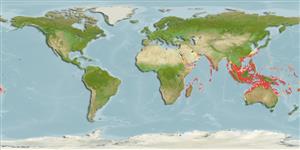Classification / Names
Common names from other countries
Main reference
Size / Weight / Age
Max length : 97.0 cm TL male/unsexed; (Ref. 40637); common length : 50.0 cm TL male/unsexed; (Ref. 55); max. published weight: 10.5 kg (Ref. 4699)
Length at first maturity
Lm ?, range 39 - ? cm
Environment
Marine; brackish; reef-associated; oceanodromous (Ref. 51243); depth range 0 - 80 m (Ref. 30573)
Climate / Range
Tropical, preferred 28°C (Ref. 107945); 31°N - 30°S, 30°E - 174°W (Ref. 55)
Distribution
Short description
Dorsal
spines
(total): 10;
Dorsal
soft rays
(total): 13-14;
Anal
spines: 3;
Anal
soft rays: 8. Dorsal profile of head steeply sloped. Preorbital width equal to eye diameter or larger. Preopercular notch and knob poorly developed. Scale rows on back parallel to lateral line. Center of each scale often with a reddish-brown spot, giving an overall appearance of series of horizontal lines on side of body. Generally yellow with a bronze to silvery sheen, shading to silvery white on belly and underside of the head. A large black blotch mainly above the lateral line below the anterior dorsal-fin rays.
IUCN Red List Status (Ref. 115185)
Threat to humans
Harmless
Human uses
Fisheries: commercial; aquaculture: commercial; gamefish: yes
Tools
Special reports
Download XML
Internet sources
Estimates of some properties based on models
Phylogenetic diversity index
PD50 = 0.5000 many relatives (e.g. carps) 0.5 - 2.0 few relatives (e.g. lungfishes)
Trophic Level
4.2 ±0.6 se; Based on diet studies.
Resilience
Medium, minimum population doubling time 1.4 - 4.4 years (K=0.13-0.38)
Vulnerability
High vulnerability (60 of 100)
Price category
